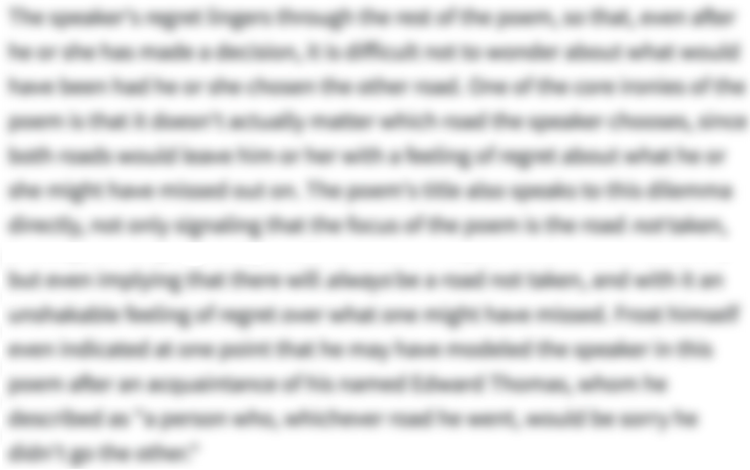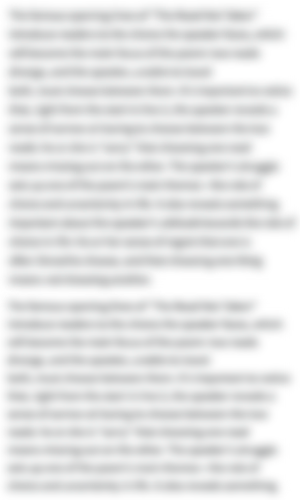-
“Desert Places” Introduction
-
"Desert Places" can be read both as a meditation on humanity's isolation in the grand scheme of the cosmos and as a reflection of the speaker's personal loneliness. This speaker, traveling at night in a snowstorm, feels profoundly alone while watching white "blankness" cover a nearby field. This blankness seems to reflect nature's general indifference toward humanity, and it may also reflect the speaker's own internal sense of detachment and desolation. The speaker finds such "desert places"—that is, the empty, isolated spaces of the earth and/or of the mind—as frightening to contemplate as the vast void of outer space. One of Robert Frost's enduringly popular poems, "Desert Places" was first published in 1934 and later collected in the Pulitzer Prize-winning volume A Further Range (1936).
-
-
“Desert Places” Summary
-
Snow and darkness were falling rapidly in a field I passed by. The ground was almost entirely blanketed in snow, except for some weeds and stalks still poking out.
The surrounding woods now dominate the landscape: it belongs to them. All the animals are hiding, snowbound, in their dens. I feel too empty and detached to matter; the scene includes me in its loneliness without realizing it.
As lonely as the scene is, it'll get even lonelier before it gets less lonely. The landscape will grow blanker and whiter in the snowy darkness, becoming expressionless and empty of any sense of human meaning.
I'm not scared when people talk about the emptiness of outer space, or about solar systems uninhabited by humans. I can scare myself quite enough with the emptiness I see close to home (or feel within me).
-
-
“Desert Places” Themes
-

Humanity's Place in the Universe
"Desert Places" expresses the dread that the whole "human race" is alone and insignificant in the cosmic scheme of things. The poem’s speaker passes by a remote field while both snow and night are “falling fast.” As snow and darkness pile up around the speaker, this landscape seems wild, deserted, and "blank[ly]" indifferent to human life. The speaker imagines that the landscape will only keep getting "blanker" until it has no visible human presence or human-friendly features at all (the speaker feels they don't "count" as a presence). The speaker dryly concludes that there's no reason to fear the alien emptiness of outer space, because the "desert places" of Earth—empty, alien-seeming landscapes closer to home—are frightening enough.
The snowfall and darkness disturb the speaker because they're diminishing or erasing virtually all signs of life. They've covered all but a few “weeds and stubble,” and the animals, who have retreated into their dens, seem “smothered,” as if the snow is burying them alive. Meanwhile, the only human being in sight (the speaker) feels “too absent-spirited to count.” That is, the speaker feels so puny and empty that it’s as though they're not even there; they've been absorbed into the larger “loneliness” of the scene. The falling snow and night thus overwhelm people, animals, and plants alike. Only the “woods”—a symbol of untamed, mysterious nature—dominate this chilling, deserted landscape.
The speaker also dreads that the "loneliness" of this snowy night will only get worse, to the point where the entire landscape seems completely inhuman. Because the darkness and snow won’t end for hours (and in fact will get more intense), the speaker says that the night “will be more lonely" before "it will be less.” The landscape will transform into something completely alien and alienating: a perfect blank with "no expression, nothing to express.”
This earthly blankness, in turn, makes the speaker think about the blankness of outer space. The lesson, for the speaker, is that there's no point in worrying about the loneliness of the cosmos because deserted landscapes on Earth can be as frightening and alienating as anything outer space holds. The speaker thus claims that other people "cannot scare me" with talk of vast cosmic distances or uninhabited solar systems, because equally empty spaces "nearer home" are already scary enough.
Where this theme appears in the poem:- Lines 1-16
-

Loneliness, Alienation, and Creative Anxiety
Frost wrote "Desert Places" during a period of depression and creative frustration. As such, it's possible that the desolate world described here represents not only the indifference of both nature and the cosmos toward human life, but also the speaker's internal feelings of isolation and emptiness. In this interpretation of the poem, what ultimately frightens the speaker while traveling alone through this dark, wintry landscape are their "own desert places": a phrase that literally refers to the bare terrain near their home, but also metaphorically suggests a psychological landscape marked by anxiety, isolation, and an inability to communicate. In other words, the poem implies that the "desert places" within the speaker's mind are just as frightening and alienating as the vast emptiness of the universe.
When the poem begins, the speaker describes darkness and snow quickly enveloping a field, "smooth[ing]" over all signs of life and humanity in the process. This clearly frightens the speaker, who opens the poem by describing the snow and darkness as “falling fast, oh, fast”—a phrase that immediately conveys anxiety. Likewise, the speaker imagines woodland creatures "smothered in their lairs," as if suffocated by the snow—another image suggesting how this snowy darkness hinders joy, vitality, and so forth. The speaker then claims that their own presence in this lonely landscape is not worth considering, because they feel “too absent-spirited to count”; they seem to have already felt hollow, detached, and/or depressed even before encountering this snowy night.
While a literal presence in the poem, then, this snowy scene also seems to remind the speaker of (and/or metaphorically represent) the landscape of their own mind. That is, it reflects the fact that the speaker feels utterly empty, alone, and unable to express themselves (possibly poetically, if readers take the speaker here to be Frost himself).
The speaker also worries that things will get worse before they get better: the night will just get darker and snowier, making the scene "more lonely ere it will be less." The speaker fears becoming more isolated, in other words, their mind becoming more "desert[ed]"—devoid of feelings of connection, creative ideas, and so forth. Projecting this sensation onto the landscape, the speaker imagines the snowy fields turning into a "blanker whiteness" with "no expression, nothing to express." Again, the physical world here seems to represent the speaker's own internal anxiety—perhaps about failing to communicate with others, and perhaps the poet's more specific fear of losing inspiration and staring at a "blank" page.
The speaker admits, finally, that "I have it in me so much nearer home / To scare myself" with "my own desert places," suggesting that the desolation they fear might be a feature of their own psyche—and that that's the scariest thought of all. From one angle, then, "Desert Places" is a fairly impersonal poem about humanity's place in nature and the universe. From another, it can be read as the personal expression of a scared, lonely, and/or creatively frustrated speaker.
Where this theme appears in the poem:- Line 1
- Lines 5-16
-
-
Line-by-Line Explanation & Analysis of “Desert Places”
-
Lines 1-4
Snow falling and ...
... stubble showing last.The first quatrain of the poem depicts a heavy snowstorm on a winter night. The speaker describes passing by a "field" in which snow and darkness were rapidly "falling." It's not clear what the speaker was doing out in this snowstorm, or where he was coming from or going. (The speaker was probably near "home," mentioned later in line 15, but it's not clear if they headed toward this home or away from it.) The field itself, meanwhile, appears to be rural farmland, with "a few weeds and stubble" showing through a nearly "smooth" blanket of snow. "Stubble" here likely refers to the cut stalks left in a harvested field of grain.
Notice that this first stanza consists of a single sentence fragment. That is, there's no main verb here; the speaker doesn't say, for example, that the snow and night were "falling" or that the ground was "almost covered smooth in snow." These omissions make the stanza feel a bit hasty and perhaps disorienting, as if the speaker is describing the scene in a breathless rush. The words seem to tumble out almost as "fast" as the falling snow and darkness, and the exclamation "oh" in line 1 ("fast, oh, fast") may further suggest that the speaker feels anxious.
The parallel phrasing (and diacope) of "Snow falling and night falling" suggests certain parallels between snow and night: for example, they're both associated with cold, and both are adverse conditions for travel. Nighttime and winter can both be symbols of death, so perhaps the speaker, wherever they're headed, is uneasily reminded that their life's journey will someday end.
The meter of this stanza is somewhat jarring and uneven. The poem is written in iambic pentameter, meaning that its lines generally contain 10 syllables arranged in a "da-DUM, da-DUM" (unstressed-stressed) rhythm. But it takes a while to actually settle into that rhythm; the pattern of stresses in the first two lines, for example, goes something like this:
Snow fal- | ling and | night fal- | ling fast, | oh, fast
In a | field I | looked in- | to go- | ing past,This unevenness suits the speaker's uneasy, anxious mood, as well as the image of a wild snowstorm. Alliterative /f/ sounds link many of the stressed syllables as well, adding emphasis and bombarding the reader like a "fast" and furious blizzard.
Finally, this stanza establishes the AABA rhyme scheme that will continue throughout the poem. (AABA-rhymed quatrains are known as rubaiyat stanzas, a form explained in more depth in the Form section of this guide.) The three rhymed lines outnumber the unrhymed line in each quatrain—perhaps even seem to overwhelm it, like snow burying the landscape. On the other hand, the unrhymed line, and especially the unrhymed end-word, stands out as unique. In this case, "snow" (line 3) stands out for good reason: it's clearly a key image in the poem!
-
Lines 5-8
The woods around ...
... includes me unawares.

Unlock all 265 words of this analysis of Lines 5-8 of “Desert Places,” and get the Line-by-Line Analysis for every poem we cover.
Plus so much more...
Get LitCharts A+ -
Lines 9-12
And lonely as ...
... nothing to express. -
Lines 13-16
They cannot scare ...
... own desert places.
-
-
“Desert Places” Symbols
-

Snow
Snow might symbolize a few things in the poem.
Like the night, the snow is a cold, enveloping force that isolates living things—and even seems to bury life altogether. (Notice those "smothered" animals in line 6, for example.) As such, snow here might represent the isolating, smothering sensation of anxiety and loneliness. The falling snow could also be read as a symbol of approaching death—the ultimate "loneliness." (There's no evidence that the speaker is actually dying, of course, but this cold, snowy landscape might remind the speaker of death's inevitability.)
In the third stanza, the snow's "blank[ness]" seems to symbolize nature's (or the universe's) indifference toward humanity, as well its lack of any ultimate meaning. The snowfall returns the familiar landscape to a "benighted" state, a primitive atmosphere much older than human "expression." The fallen snow has no relatable "expression" of its own, and "nothing to express." It's like a featureless face staring blankly and coldly at humanity, or an empty, meaningless sheet of paper.
If the speaker is a stand-in for the poet, this blankness might be a projection of the poet's creative frustrations: his inability to "express" and make sense of the world. But it might also, symbolically, suggest that there's no sense to be made—that the world is meaningless, at least in human terms.
Where this symbol appears in the poem:- Lines 1-4
- Line 6
- Lines 9-12
-

Woods
In line 5, the speaker describes the woods as owning or dominating the snowy landscape: "The woods around it have it—it is theirs." On a literal level, this detail suggests that the accumulating snow has covered everything in sight except for the tall forest trees. On a symbolic level, the woods represent wild, primitive nature. Their dominance suggests that nature is reasserting its power over the landscape, which human beings had seemed to tame (with their cultivated "field[s]" full of harvest "stubble" in lines 2 and 4). The world of the poem seems to be returning to a primitive or "benighted" state (line 11), in which people are small, vulnerable, and meaningless. Or maybe the poem is suggesting that was its true state all along!
Frost often used woods as symbols of a natural wildness that could be both ominous and darkly thrilling. Other examples occur in poems such as "Into My Own" and "Stopping by Woods on a Snowy Evening."
Where this symbol appears in the poem:- Line 5: “The woods around it have it—it is theirs.”
-
-
“Desert Places” Poetic Devices & Figurative Language
-
Alliteration
"Desert Places" uses plenty of alliteration, often to reinforce the imagery it's describing or to highlight important words and ideas.
Lines 1-2, for example, contain a number of emphatic /f/ words, which help create a driving, slightly uneven rhythm:
Snow falling and night falling fast, oh, fast
In a field I looked into going past,The thick, chaotic swirl of /f/ sounds might be compared to the thick, swirling snowfall. In the same stanza, the soft, repeated /s/ sounds of "smooth in snow" seem to make the phrase itself run more smoothly.
In the third stanza, alliteration links a number of thematically meaningful words. Consider the /l/ words "lonely," "loneliness," "lonely," and "less" (lines 9-10); the /b/ words "blanker" and "benighted" (line 11); and the /n/ words "no" and "nothing" (line 12): not the world's most cheerful group! These words have to do with isolation, diminishment, darkness, and nothingness: key themes in a poem that's all about inner as well as outer desolation. Again, alliteration also simply makes the language flow smoothly, subtly mirroring the smooth blanket of snow being described.
Finally, a run of /s/ words appears in lines 13-14: "scare," "spaces," "stars," "stars." This sibilance sounds a bit eerie, like whispering or hissing—an appropriate effect for lines about vast, chilling emptiness.
Where alliteration appears in the poem:- Line 1: “falling,” “falling fast,” “fast”
- Line 2: “field”
- Line 3: “smooth,” “snow”
- Line 9: “lonely,” “loneliness”
- Line 10: “lonely,” “less”
- Line 11: “blanker,” “benighted”
- Line 12: “no,” “expression,” “nothing,” “express”
- Line 13: “scare,” “spaces”
- Line 14: “stars,” “stars”
-
Assonance


Unlock all 210 words of this analysis of Assonance in “Desert Places,” and get the poetic device analyses for every poem we cover.
Plus so much more...
Get LitCharts A+ -
Parallelism
-
Diacope
-
Metaphor
-
Juxtaposition
-
Enjambment
-
-
“Desert Places” Vocabulary
Select any word below to get its definition in the context of the poem. The words are listed in the order in which they appear in the poem.
- Stubble
- Lairs
- Absent-spirited
- Unawares
- Ere
- Benighted
- Desert
Stubble-
(Location in poem: Line 4: “But a few weeds and stubble showing last.”)
The short, cut stalks of a harvested field.
-
Form, Meter, & Rhyme Scheme of “Desert Places”
-
Form
"Desert Places" consists of four quatrains (a.k.a. four-line stanzas). These are more specifically something called rubaiyat stanzas, meaning:
- Each stanza has an AABA rhyme scheme. In other words, the first, second, and fourth lines of each quatrain rhyme, while the third line is unrhymed. (However, two of the poem's unrhymed lines, lines 3 and 11, end with the same word: "snow." That's one sign of the importance of snow in the poem!)
- Each line is written iambic pentameter: that is, they generally consist of 10 syllables that follow a "da-DUM, da-DUM" rhythm. (Not all rubaiyat stanzas use pentameter, but it's common.)
Rubaiyat (sometimes rendered rubāʿiyāt or rubáiyát) is the plural of the Persian term rubaʿi, meaning quatrain. In classical Persian poetry, the rubaʿi form followed a different meter but was conventionally rhymed AABA or AAAA. This form was adapted into English in the 19th century, beginning with poet Edward FitzGerald's loose translation of selected rubáiyát attributed to the classical Persian astronomer and poet Omar Khayyam. The Rubáiyát of Omar Khayyám (1859) was a popular success and inspired other English-language poets to use this form in subsequent decades.
FitzGerald's translation was notable for its religious skepticism (an outlook the original poet may have shared, though this question is still debated). Frost's "Desert Places," with its skeptical view of humanity's place in the universe, may use the rubaiyat form partly in order to evoke the wry cosmic pessimism of Khayyam/FitzGerald. Frost also used versions of this form on other occasions, including in "Stopping by Woods on a Snowy Evening" (a poem whose setting and themes overlap with those of "Desert Places").
-
Meter
The poem's meter is iambic pentameter, meaning that its lines typically contain 10 syllables arranged in a "da-DUM | da-DUM | da-DUM | da-DUM | da-DUM" stress pattern. (That is, they typically contain five iambs, or metrical feet consisting of an unstressed followed by a stressed syllable.)
That's the basic pattern, anyway—but Frost roughens it up a bit, as he often does. The first line of perfect iambic pentameter doesn't arrive until line 5:
The woods | around | it have | it—it | is theirs.
Until then, every line contains metrical variations, and lines 1-2 are especially weird and wild:
Snow fal- | ling and | night fal- | ling fast, | oh, fast
In a | field I | looked in- | to go- | ing past,There are other ways to read the meter in these lines; the point is, they're well off the groove of the iambic pattern. This unevenness might reflect the whirling chaos of the snowstorm, as well as the anxious, unsettled mood of the speaker.
As the poem goes on, the meter reinforces meaning in other ways, too. For example, the third stanza is metrically smooth, with few variations—perhaps mirroring the snow's "expression[less]" smoothness.
-
Rhyme Scheme
The poem is written in quatrains that rhyme AABA. The first, second, and final lines of each stanza rhyme, while the third is unrhymed:
[...] fast A
[...] past, A
[...] snow, B
[...] last. AThis kind of quatrain is known as a rubaiyat stanza, after the classical Persian form called the rubaʿi (plural rubāʿiyāt). In English-language poetry, this form is especially associated with the Rubáiyát of Omar Khayyám (1859), a translation by the English poet Edward FitzGerald. That book's desert settings and skeptical outlook may have influenced "Desert Places" (see Form and Context sections for more).
The AABA rhyme scheme has other effects that subtly shape, or reinforce, the poem's meaning. The flurry of A rhymes in each stanza has a heavy, cumulative impact that might be compared to the accumulating snowfall. Meanwhile, the unrhymed end word in the third line serves as the "exception to the rule" and therefore stands out. In the first and third stanzas, this effect draws attention to the word "snow"—obviously an important image in the poem! In the final stanza, it draws attention to the word "home," a complicated and possibly ironic word for this lonely, alienated speaker.
-
-
“Desert Places” Speaker
-
"Desert Places" has a generic first-person speaker whose name, gender, occupation, etc. are never specified. This speaker is traveling through rural woods and farmland on a snowy night, but it's not clear where they're coming from, where they're going, or why they're out in the cold weather. The lack of specificity makes the speaker seem more universal, in keeping with a poem that portrays a kind of universal "loneliness."
Of course, the speaker could also be a stand-in for the poet. The general voice and setting are consistent with many other Frost poems (including "Stopping by Woods on a Snowy Evening"), and the references to "blanker whiteness" and having "nothing to express" (lines 11-12) might reflect the creative frustrations of a poet who fears the blank page.
In any case, most of what the reader learns about the speaker concerns their mood or psychological state. The speaker feels "absent-spirited"—empty or distracted, as if they're not really there—and suggests that they don't even "count" as part of the larger scenery. They share the "loneliness" of their surroundings (or project their loneliness onto their surroundings), and they seem unnerved by the blank emptiness of the snowy landscape. They "scare" themselves with "[their] own desert places," which presumably include this landscape—but might also include an internal sense of emptiness. Overall, the speaker seems to feel hollow or numb in a way that corresponds with the barren, snowy fields.
-
-
“Desert Places” Setting
-
"Desert Places" is set in a rural landscape on a snowy winter night. A number of Robert Frost poems use this kind of setting, including the famous "Stopping by Woods on a Snowy Evening." Frost himself is particularly associated with rural New England, where he lived for most of his adult life, but nothing in this poem specifies a geographical location.
The "field" the speaker passes is cultivated farmland; the "stubble" showing through the snow refers to cut stalks of harvested grain. This farmland is surrounded by wilder "woods," whose tall trees seem to dominate the scene ("it is theirs") once the snowfall has blanketed everything else. All the animals in the vicinity are burrowed in their dens, or, as the speaker puts it, "smothered in their lairs." The speaker appears to be the only living creature out in this snowstorm, and even he feels "too absent-spirited to count."
The speaker expects the snow and darkness to last for many more hours, meaning that the night will grow "more lonely" before it grows "less." The speaker also situates this barren scene within a wider universe, full of vast, empty spaces "Between stars" and "on stars where no human race is." In this way, the poem makes the loneliness of its rural landscape seem universal.
-
-
Literary and Historical Context of “Desert Places”
Literary Context
"Desert Places" was written in 1933, first published in the journal The American Mercury in 1934, and collected in A Further Range (1936), the volume that won Robert Frost his third of four Pulitzer Prizes in Poetry. It remains one of the better-known poems from that volume, which also includes such widely anthologized classics as "Neither Out Far nor in Deep" and "Provide, Provide."
Though widely read and much honored during his lifetime, some audiences originally viewed Frost as a quaint, folksy writer: a kind of backwoods New England sage. In 1958, the famous literary critic Lionel Trilling helped change this perception when he called the elderly Frost "a terrifying poet." Though Frost remained steadfastly traditional in his use of meter and rhyme, he displayed a very modern, scientifically informed skepticism—sometimes even a chilling pessimism—in poems like "Desert Places," "Design," "The Most of It," and others. Many of Frost's poems, including "Desert Places" and the famous "Stopping by Woods on a Snowy Evening," feature solitary characters, rural settings, and metaphors that explore the relationship between humanity and nature.
"Desert Places" uses something called rubaiyat stanzas: iambic pentameter quatrains that follow an AABA rhyme scheme (more on this in the Form, Meter, and Rhyme Scheme sections of this guide). This stanza is based on a classical Persian form popularized in English by Edward FitzGerald's Rubáiyát of Omar Khayyám (1859), a loose translation of various rubáiyát attributed to the Persian scientist and poet Omar Khayyam (1048-1131). This book is remembered for its mix of hedonism, religious skepticism, and worldly pessimism. Readers can hear the last of those qualities in this excerpt (which, like Frost's poem, features the words "Desert" and "Snow"):
The Worldly Hope men set their Hearts upon
Turns Ashes—or it prospers; and anon,
Like Snow upon the Desert's dusty Face,
Lighting a little hour or two—is gone.Frost isn't necessarily alluding to the Rubáiyát through his use of rubaiyat stanzas, but the older book may have had some influence on the form and tone of "Desert Places."
Historical Context
"Desert Places" takes place in a barren, timeless-seeming winter landscape. It doesn't mention any historical figures or events; unlike Frost's "Stopping by Woods on a Snowy Evening," which it resembles in some ways, it doesn't even include period details such as a horse with "harness bells." However, a few of its features may subtly reflect the life and times of the poet.
Frost wrote "Desert Places" during a winter in which he struggled with depression. Some scholars have interpreted the poem in autobiographical terms, suggesting that it reflects Frost's personal alienation and anxieties about creative decline—his fear that he, like the snow, had "nothing to express" (lines 11-12). For example, the biographer Henry Hart has claimed that Frost "transfigured his disenchantment with life" into this "haunting" poem.
The last stanza of the poem may also allude to then-recent discoveries in the field of astronomy. In 1923, astronomer Edwin Hubble proved that other galaxies exist beyond the Milky Way; in 1929, he confirmed Georges Lemaître's theory that the universe is expanding. In 1930, astronomer Clyde Lombaugh confirmed the existence of the barren dwarf planet Pluto. All these events happened in the decade or so before Frost wrote "Desert Places," and any or all may have informed the poem's reference to "empty spaces / Between stars—on stars where no human race is" (lines 13-14). These lines seem to reflect a modern view of the universe as vaster and emptier than pre-20th-century science had ever imagined. Perhaps the "They" who "cannot scare" the poem's speaker refers to the scientists who kept showing how lonely outer space is!
-
More “Desert Places” Resources
-
External Resources
-
The Poem Aloud — Listen to a reading of the poem, courtesy of The Frost Place.
-
The Poet's Life and Work — Read a biography of Frost at Poets.org.
-
More on Frost — A video biography of the poet.
-
Frost's Ideas About the World — Listen to a talk on "Frost as a Thinker" by poet Don Paterson.
-
Frost's Landscapes — A photo essay about the rural New England scenery that inspired much of Frost's poetry.
-
-
LitCharts on Other Poems by Robert Frost
-








